University of the Sunshine Coast BUS703 Article Critique Assignment
VerifiedAdded on 2022/10/12
|7
|1738
|82
Homework Assignment
AI Summary
This assignment is a critical analysis of a research article by Sheehan and Nelson (2005) focusing on variations in job satisfaction between permanent and casual workers in a call center setting. The critique evaluates the literature review, assessing its depth, relevance, and use of cited sources, while also pointing out its weaknesses such as the use of older articles. The methods used for data collection, including questionnaires and interviews, are examined for justification and description, with recommendations for improvement. The sampling strategy is critiqued for its size, representativeness of the population, and balance between different groups of respondents. Furthermore, the assignment assesses the research ethics, specifically regarding the anonymity and confidentiality of the respondents, identifying both strengths and weaknesses in the approach taken by the authors. The analysis highlights the importance of ethical considerations, such as voluntary participation and potential influences on responses, in ensuring the validity and reliability of the research findings. This assignment demonstrates an understanding of research methodologies and their application in evaluating the strengths and weaknesses of the study.
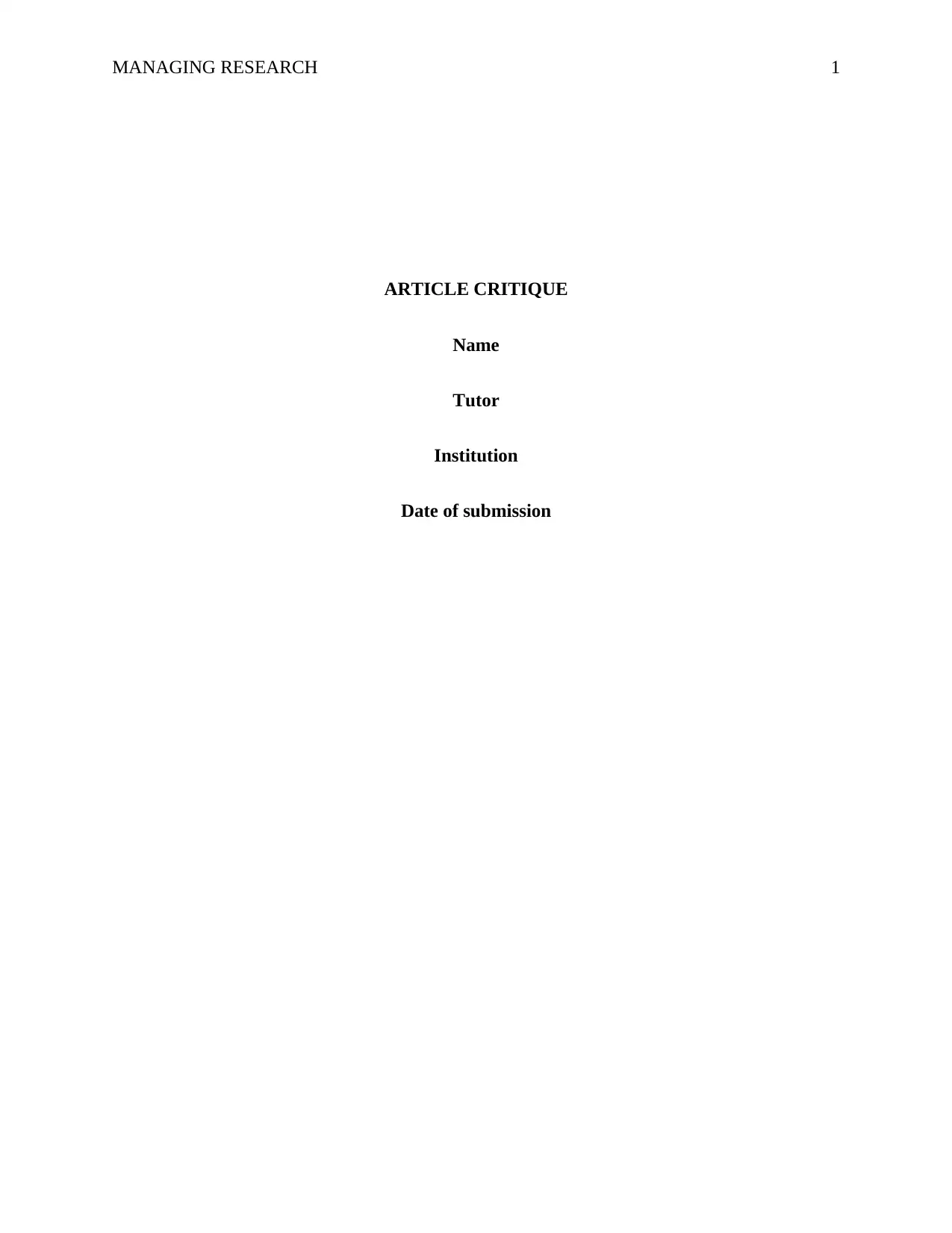
MANAGING RESEARCH 1
ARTICLE CRITIQUE
Name
Tutor
Institution
Date of submission
ARTICLE CRITIQUE
Name
Tutor
Institution
Date of submission
Paraphrase This Document
Need a fresh take? Get an instant paraphrase of this document with our AI Paraphraser
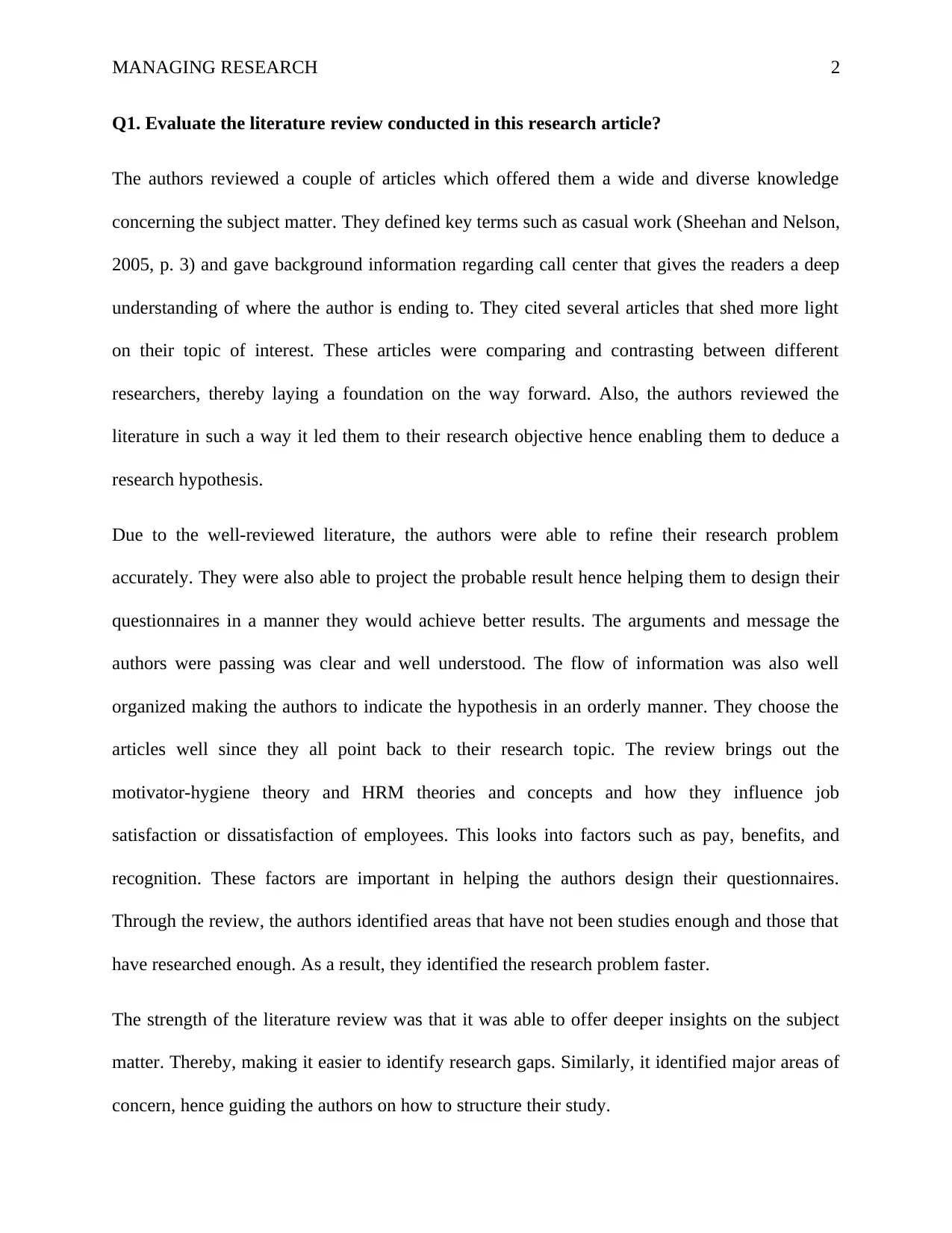
MANAGING RESEARCH 2
Q1. Evaluate the literature review conducted in this research article?
The authors reviewed a couple of articles which offered them a wide and diverse knowledge
concerning the subject matter. They defined key terms such as casual work (Sheehan and Nelson,
2005, p. 3) and gave background information regarding call center that gives the readers a deep
understanding of where the author is ending to. They cited several articles that shed more light
on their topic of interest. These articles were comparing and contrasting between different
researchers, thereby laying a foundation on the way forward. Also, the authors reviewed the
literature in such a way it led them to their research objective hence enabling them to deduce a
research hypothesis.
Due to the well-reviewed literature, the authors were able to refine their research problem
accurately. They were also able to project the probable result hence helping them to design their
questionnaires in a manner they would achieve better results. The arguments and message the
authors were passing was clear and well understood. The flow of information was also well
organized making the authors to indicate the hypothesis in an orderly manner. They choose the
articles well since they all point back to their research topic. The review brings out the
motivator-hygiene theory and HRM theories and concepts and how they influence job
satisfaction or dissatisfaction of employees. This looks into factors such as pay, benefits, and
recognition. These factors are important in helping the authors design their questionnaires.
Through the review, the authors identified areas that have not been studies enough and those that
have researched enough. As a result, they identified the research problem faster.
The strength of the literature review was that it was able to offer deeper insights on the subject
matter. Thereby, making it easier to identify research gaps. Similarly, it identified major areas of
concern, hence guiding the authors on how to structure their study.
Q1. Evaluate the literature review conducted in this research article?
The authors reviewed a couple of articles which offered them a wide and diverse knowledge
concerning the subject matter. They defined key terms such as casual work (Sheehan and Nelson,
2005, p. 3) and gave background information regarding call center that gives the readers a deep
understanding of where the author is ending to. They cited several articles that shed more light
on their topic of interest. These articles were comparing and contrasting between different
researchers, thereby laying a foundation on the way forward. Also, the authors reviewed the
literature in such a way it led them to their research objective hence enabling them to deduce a
research hypothesis.
Due to the well-reviewed literature, the authors were able to refine their research problem
accurately. They were also able to project the probable result hence helping them to design their
questionnaires in a manner they would achieve better results. The arguments and message the
authors were passing was clear and well understood. The flow of information was also well
organized making the authors to indicate the hypothesis in an orderly manner. They choose the
articles well since they all point back to their research topic. The review brings out the
motivator-hygiene theory and HRM theories and concepts and how they influence job
satisfaction or dissatisfaction of employees. This looks into factors such as pay, benefits, and
recognition. These factors are important in helping the authors design their questionnaires.
Through the review, the authors identified areas that have not been studies enough and those that
have researched enough. As a result, they identified the research problem faster.
The strength of the literature review was that it was able to offer deeper insights on the subject
matter. Thereby, making it easier to identify research gaps. Similarly, it identified major areas of
concern, hence guiding the authors on how to structure their study.
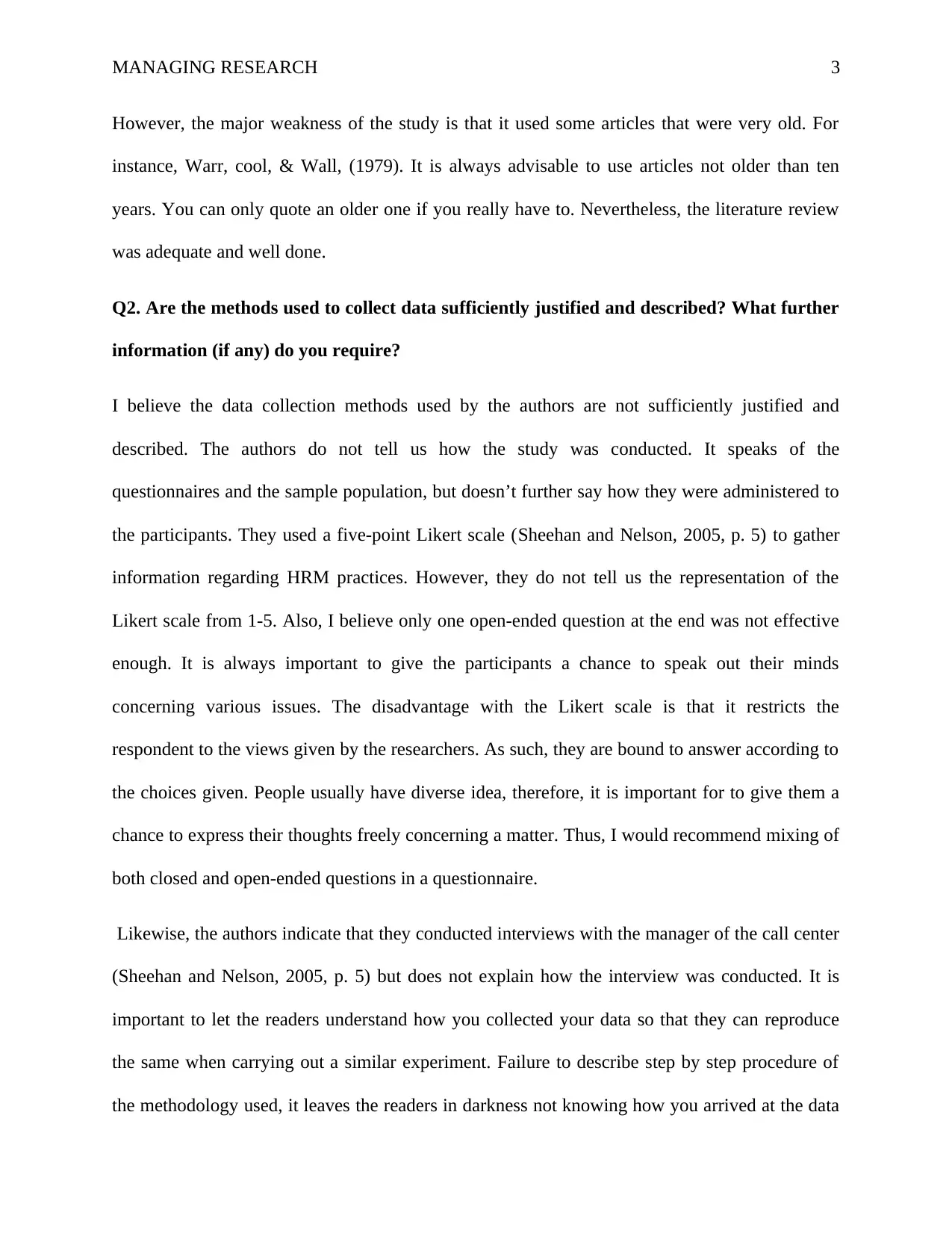
MANAGING RESEARCH 3
However, the major weakness of the study is that it used some articles that were very old. For
instance, Warr, cool, & Wall, (1979). It is always advisable to use articles not older than ten
years. You can only quote an older one if you really have to. Nevertheless, the literature review
was adequate and well done.
Q2. Are the methods used to collect data sufficiently justified and described? What further
information (if any) do you require?
I believe the data collection methods used by the authors are not sufficiently justified and
described. The authors do not tell us how the study was conducted. It speaks of the
questionnaires and the sample population, but doesn’t further say how they were administered to
the participants. They used a five-point Likert scale (Sheehan and Nelson, 2005, p. 5) to gather
information regarding HRM practices. However, they do not tell us the representation of the
Likert scale from 1-5. Also, I believe only one open-ended question at the end was not effective
enough. It is always important to give the participants a chance to speak out their minds
concerning various issues. The disadvantage with the Likert scale is that it restricts the
respondent to the views given by the researchers. As such, they are bound to answer according to
the choices given. People usually have diverse idea, therefore, it is important for to give them a
chance to express their thoughts freely concerning a matter. Thus, I would recommend mixing of
both closed and open-ended questions in a questionnaire.
Likewise, the authors indicate that they conducted interviews with the manager of the call center
(Sheehan and Nelson, 2005, p. 5) but does not explain how the interview was conducted. It is
important to let the readers understand how you collected your data so that they can reproduce
the same when carrying out a similar experiment. Failure to describe step by step procedure of
the methodology used, it leaves the readers in darkness not knowing how you arrived at the data
However, the major weakness of the study is that it used some articles that were very old. For
instance, Warr, cool, & Wall, (1979). It is always advisable to use articles not older than ten
years. You can only quote an older one if you really have to. Nevertheless, the literature review
was adequate and well done.
Q2. Are the methods used to collect data sufficiently justified and described? What further
information (if any) do you require?
I believe the data collection methods used by the authors are not sufficiently justified and
described. The authors do not tell us how the study was conducted. It speaks of the
questionnaires and the sample population, but doesn’t further say how they were administered to
the participants. They used a five-point Likert scale (Sheehan and Nelson, 2005, p. 5) to gather
information regarding HRM practices. However, they do not tell us the representation of the
Likert scale from 1-5. Also, I believe only one open-ended question at the end was not effective
enough. It is always important to give the participants a chance to speak out their minds
concerning various issues. The disadvantage with the Likert scale is that it restricts the
respondent to the views given by the researchers. As such, they are bound to answer according to
the choices given. People usually have diverse idea, therefore, it is important for to give them a
chance to express their thoughts freely concerning a matter. Thus, I would recommend mixing of
both closed and open-ended questions in a questionnaire.
Likewise, the authors indicate that they conducted interviews with the manager of the call center
(Sheehan and Nelson, 2005, p. 5) but does not explain how the interview was conducted. It is
important to let the readers understand how you collected your data so that they can reproduce
the same when carrying out a similar experiment. Failure to describe step by step procedure of
the methodology used, it leaves the readers in darkness not knowing how you arrived at the data
⊘ This is a preview!⊘
Do you want full access?
Subscribe today to unlock all pages.

Trusted by 1+ million students worldwide
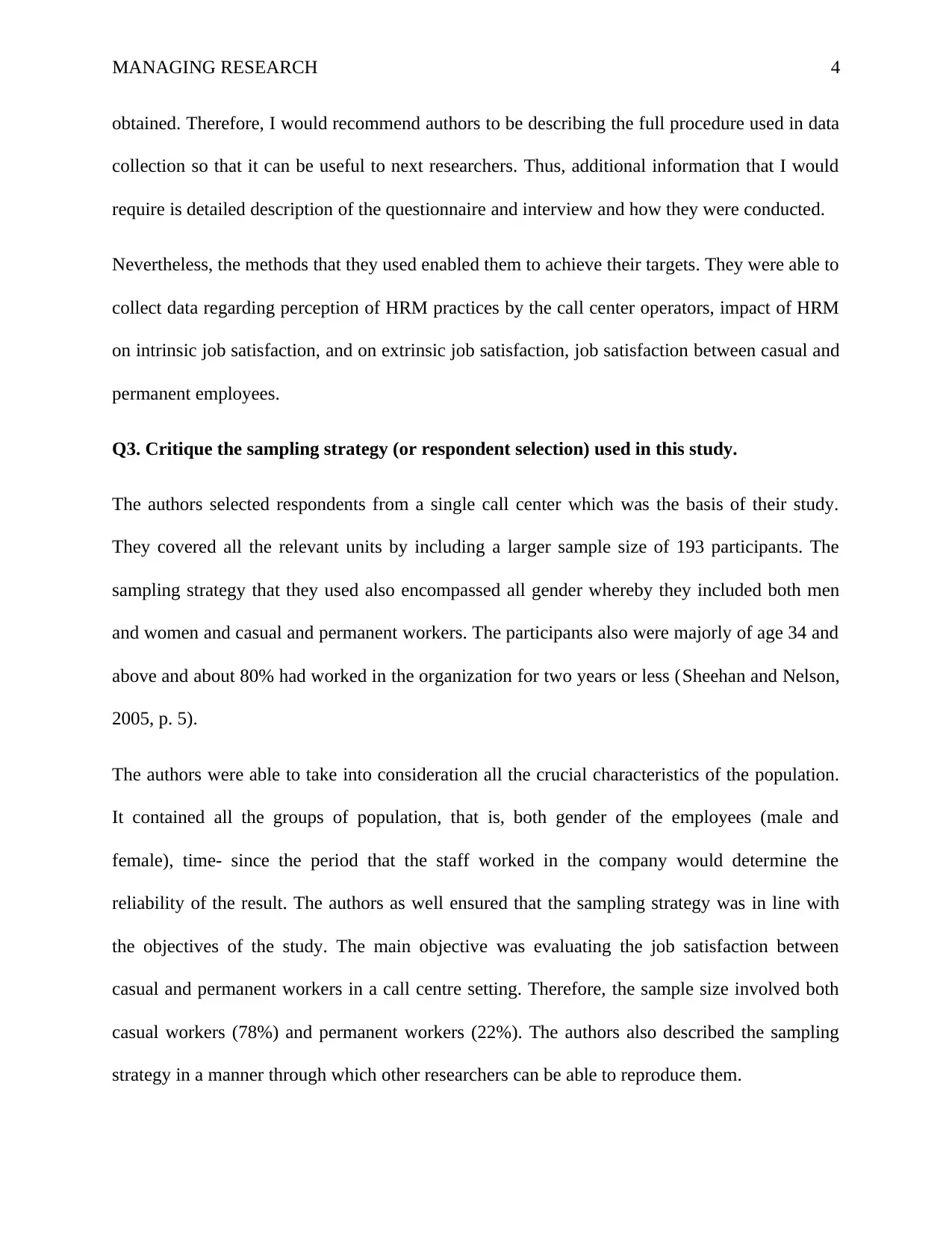
MANAGING RESEARCH 4
obtained. Therefore, I would recommend authors to be describing the full procedure used in data
collection so that it can be useful to next researchers. Thus, additional information that I would
require is detailed description of the questionnaire and interview and how they were conducted.
Nevertheless, the methods that they used enabled them to achieve their targets. They were able to
collect data regarding perception of HRM practices by the call center operators, impact of HRM
on intrinsic job satisfaction, and on extrinsic job satisfaction, job satisfaction between casual and
permanent employees.
Q3. Critique the sampling strategy (or respondent selection) used in this study.
The authors selected respondents from a single call center which was the basis of their study.
They covered all the relevant units by including a larger sample size of 193 participants. The
sampling strategy that they used also encompassed all gender whereby they included both men
and women and casual and permanent workers. The participants also were majorly of age 34 and
above and about 80% had worked in the organization for two years or less (Sheehan and Nelson,
2005, p. 5).
The authors were able to take into consideration all the crucial characteristics of the population.
It contained all the groups of population, that is, both gender of the employees (male and
female), time- since the period that the staff worked in the company would determine the
reliability of the result. The authors as well ensured that the sampling strategy was in line with
the objectives of the study. The main objective was evaluating the job satisfaction between
casual and permanent workers in a call centre setting. Therefore, the sample size involved both
casual workers (78%) and permanent workers (22%). The authors also described the sampling
strategy in a manner through which other researchers can be able to reproduce them.
obtained. Therefore, I would recommend authors to be describing the full procedure used in data
collection so that it can be useful to next researchers. Thus, additional information that I would
require is detailed description of the questionnaire and interview and how they were conducted.
Nevertheless, the methods that they used enabled them to achieve their targets. They were able to
collect data regarding perception of HRM practices by the call center operators, impact of HRM
on intrinsic job satisfaction, and on extrinsic job satisfaction, job satisfaction between casual and
permanent employees.
Q3. Critique the sampling strategy (or respondent selection) used in this study.
The authors selected respondents from a single call center which was the basis of their study.
They covered all the relevant units by including a larger sample size of 193 participants. The
sampling strategy that they used also encompassed all gender whereby they included both men
and women and casual and permanent workers. The participants also were majorly of age 34 and
above and about 80% had worked in the organization for two years or less (Sheehan and Nelson,
2005, p. 5).
The authors were able to take into consideration all the crucial characteristics of the population.
It contained all the groups of population, that is, both gender of the employees (male and
female), time- since the period that the staff worked in the company would determine the
reliability of the result. The authors as well ensured that the sampling strategy was in line with
the objectives of the study. The main objective was evaluating the job satisfaction between
casual and permanent workers in a call centre setting. Therefore, the sample size involved both
casual workers (78%) and permanent workers (22%). The authors also described the sampling
strategy in a manner through which other researchers can be able to reproduce them.
Paraphrase This Document
Need a fresh take? Get an instant paraphrase of this document with our AI Paraphraser
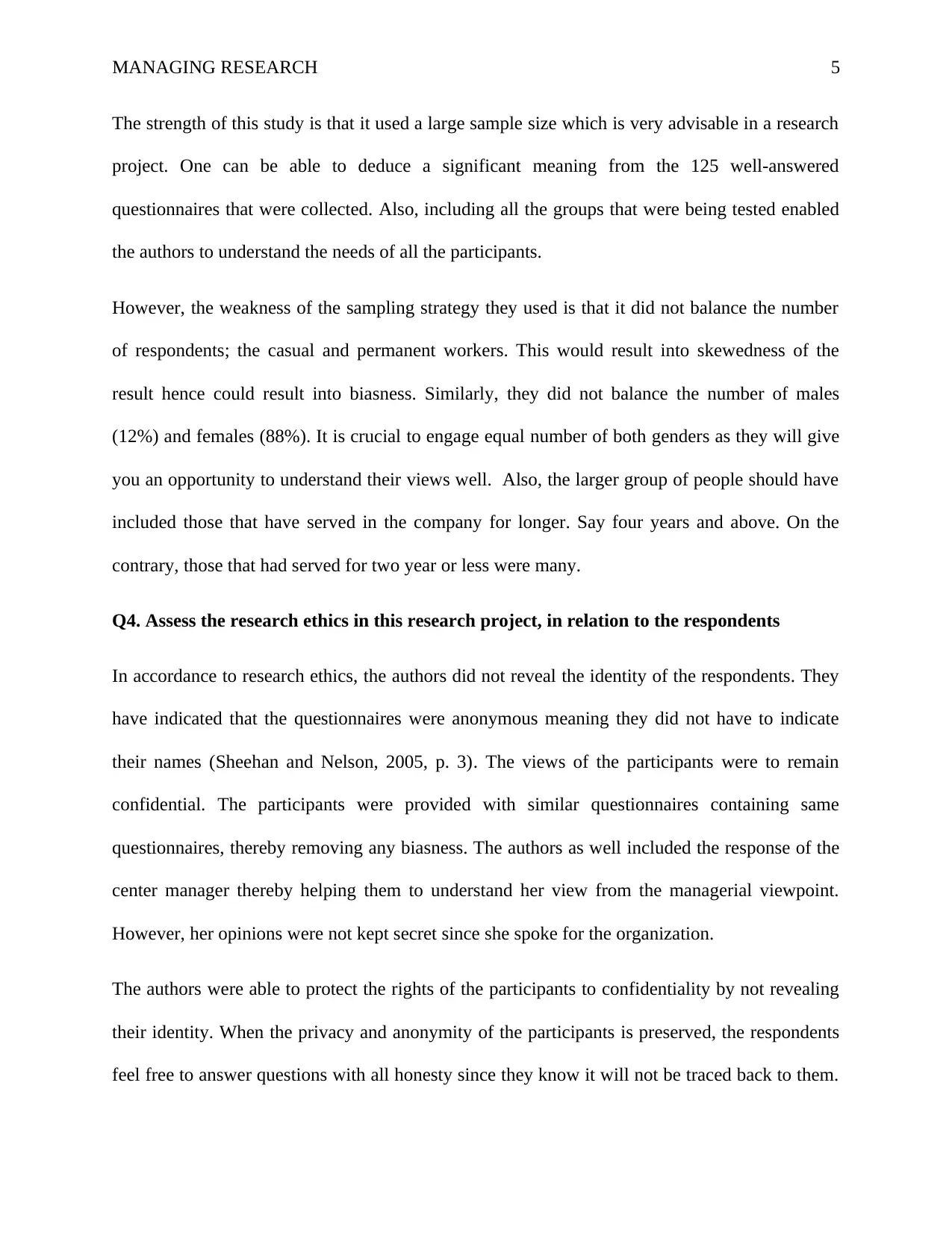
MANAGING RESEARCH 5
The strength of this study is that it used a large sample size which is very advisable in a research
project. One can be able to deduce a significant meaning from the 125 well-answered
questionnaires that were collected. Also, including all the groups that were being tested enabled
the authors to understand the needs of all the participants.
However, the weakness of the sampling strategy they used is that it did not balance the number
of respondents; the casual and permanent workers. This would result into skewedness of the
result hence could result into biasness. Similarly, they did not balance the number of males
(12%) and females (88%). It is crucial to engage equal number of both genders as they will give
you an opportunity to understand their views well. Also, the larger group of people should have
included those that have served in the company for longer. Say four years and above. On the
contrary, those that had served for two year or less were many.
Q4. Assess the research ethics in this research project, in relation to the respondents
In accordance to research ethics, the authors did not reveal the identity of the respondents. They
have indicated that the questionnaires were anonymous meaning they did not have to indicate
their names (Sheehan and Nelson, 2005, p. 3). The views of the participants were to remain
confidential. The participants were provided with similar questionnaires containing same
questionnaires, thereby removing any biasness. The authors as well included the response of the
center manager thereby helping them to understand her view from the managerial viewpoint.
However, her opinions were not kept secret since she spoke for the organization.
The authors were able to protect the rights of the participants to confidentiality by not revealing
their identity. When the privacy and anonymity of the participants is preserved, the respondents
feel free to answer questions with all honesty since they know it will not be traced back to them.
The strength of this study is that it used a large sample size which is very advisable in a research
project. One can be able to deduce a significant meaning from the 125 well-answered
questionnaires that were collected. Also, including all the groups that were being tested enabled
the authors to understand the needs of all the participants.
However, the weakness of the sampling strategy they used is that it did not balance the number
of respondents; the casual and permanent workers. This would result into skewedness of the
result hence could result into biasness. Similarly, they did not balance the number of males
(12%) and females (88%). It is crucial to engage equal number of both genders as they will give
you an opportunity to understand their views well. Also, the larger group of people should have
included those that have served in the company for longer. Say four years and above. On the
contrary, those that had served for two year or less were many.
Q4. Assess the research ethics in this research project, in relation to the respondents
In accordance to research ethics, the authors did not reveal the identity of the respondents. They
have indicated that the questionnaires were anonymous meaning they did not have to indicate
their names (Sheehan and Nelson, 2005, p. 3). The views of the participants were to remain
confidential. The participants were provided with similar questionnaires containing same
questionnaires, thereby removing any biasness. The authors as well included the response of the
center manager thereby helping them to understand her view from the managerial viewpoint.
However, her opinions were not kept secret since she spoke for the organization.
The authors were able to protect the rights of the participants to confidentiality by not revealing
their identity. When the privacy and anonymity of the participants is preserved, the respondents
feel free to answer questions with all honesty since they know it will not be traced back to them.
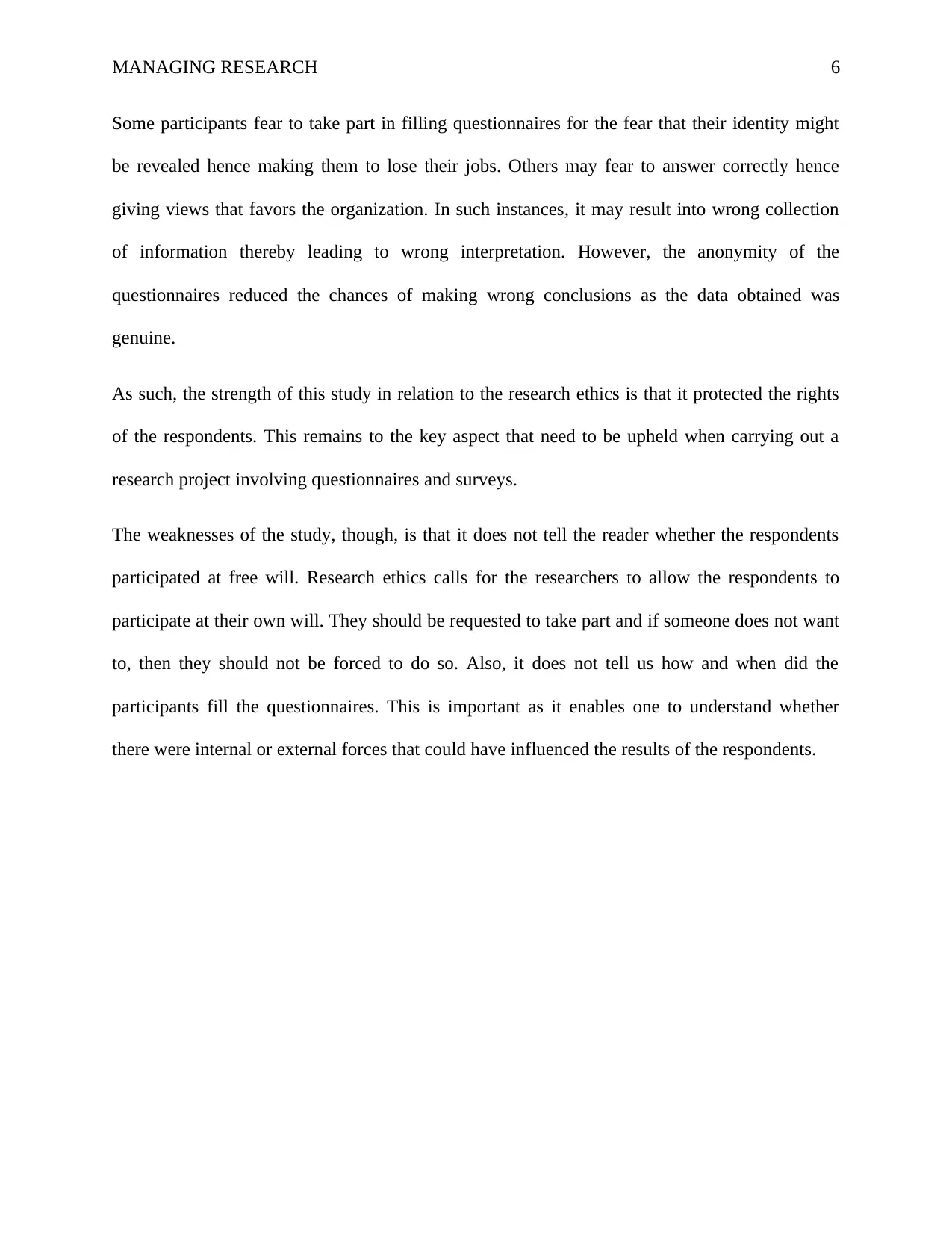
MANAGING RESEARCH 6
Some participants fear to take part in filling questionnaires for the fear that their identity might
be revealed hence making them to lose their jobs. Others may fear to answer correctly hence
giving views that favors the organization. In such instances, it may result into wrong collection
of information thereby leading to wrong interpretation. However, the anonymity of the
questionnaires reduced the chances of making wrong conclusions as the data obtained was
genuine.
As such, the strength of this study in relation to the research ethics is that it protected the rights
of the respondents. This remains to the key aspect that need to be upheld when carrying out a
research project involving questionnaires and surveys.
The weaknesses of the study, though, is that it does not tell the reader whether the respondents
participated at free will. Research ethics calls for the researchers to allow the respondents to
participate at their own will. They should be requested to take part and if someone does not want
to, then they should not be forced to do so. Also, it does not tell us how and when did the
participants fill the questionnaires. This is important as it enables one to understand whether
there were internal or external forces that could have influenced the results of the respondents.
Some participants fear to take part in filling questionnaires for the fear that their identity might
be revealed hence making them to lose their jobs. Others may fear to answer correctly hence
giving views that favors the organization. In such instances, it may result into wrong collection
of information thereby leading to wrong interpretation. However, the anonymity of the
questionnaires reduced the chances of making wrong conclusions as the data obtained was
genuine.
As such, the strength of this study in relation to the research ethics is that it protected the rights
of the respondents. This remains to the key aspect that need to be upheld when carrying out a
research project involving questionnaires and surveys.
The weaknesses of the study, though, is that it does not tell the reader whether the respondents
participated at free will. Research ethics calls for the researchers to allow the respondents to
participate at their own will. They should be requested to take part and if someone does not want
to, then they should not be forced to do so. Also, it does not tell us how and when did the
participants fill the questionnaires. This is important as it enables one to understand whether
there were internal or external forces that could have influenced the results of the respondents.
⊘ This is a preview!⊘
Do you want full access?
Subscribe today to unlock all pages.

Trusted by 1+ million students worldwide

MANAGING RESEARCH 7
Reference
Sheehan, C.R. and Nelson, L.F., 2005. Variations in job satisfaction for permanent and casual
workers. In Australian and New Zealand Academy of Management Conference 2005 (pp. 1-15).
ANZAM.
Reference
Sheehan, C.R. and Nelson, L.F., 2005. Variations in job satisfaction for permanent and casual
workers. In Australian and New Zealand Academy of Management Conference 2005 (pp. 1-15).
ANZAM.
1 out of 7
Related Documents
Your All-in-One AI-Powered Toolkit for Academic Success.
+13062052269
info@desklib.com
Available 24*7 on WhatsApp / Email
![[object Object]](/_next/static/media/star-bottom.7253800d.svg)
Unlock your academic potential
Copyright © 2020–2025 A2Z Services. All Rights Reserved. Developed and managed by ZUCOL.





